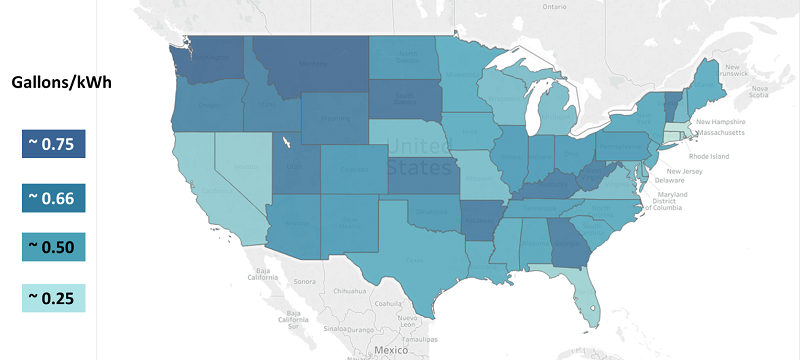The water-energy nexus is a nascent topic in the building industry. The impact on water systems linked to energy generation has important ecological, conservation, and sustainability implications, particularly in water-strained areas such as the Southwestern desert of the United States. The vast majority of power plants in the United States burn fuels – most commonly coal and natural gas – in traditional thermoelectric power generation. In these power plants, water provides a cooling source to condense steam. This process requires various amounts of water depending on several factors, including the age of the plant and the fuel consumed, among others. Water consumed from energy generation is primarily lost to the atmosphere via evaporation, most commonly from a cooling tower or from a reservoir’s surface.
NBI has laid the groundwork to connect the water-energy nexus at the power plant with the energy consumed at the building level. With the support of existing research and funding from the Edwards Mother Earth Foundation, NBI has created a calculation tool to estimate the watershed impacts of building electricity use and compare it to onsite water consumption (toilets, faucets, etc.). Users provide basic inputs for a baseline and proposed building to visualize the potential savings for each category.
Research shows that the water cost of energy consumption ranges from about 0.25 to 0.75 gallons per kWh, depending on the state. One large factor is hydropower, which loses large quantities of water to surface evaporation in the reservoir. For this reason, the Pacific Northwest is particularly water intensive, even though it is generally less carbon intensive than other parts of the country.

Let’s consider a new office building which plans to save 20% energy and 20% water through efficient fixtures over modern energy codes. What impact do you expect the water-energy savings from efficiency to be? NBI’s simulation shows that the water savings at the generation source from energy efficiency enhancements are on the same order of magnitude as the building-level water savings—20%. In some states, the water saved through energy efficiency outweighs the building-level water savings. Imagine the impact that energy savings in less efficient existing buildings with cost-effective energy retrofits could have on the overall water consumption for the region. These water savings are particularly important in regions with historical or anticipated droughts and water shortages.
The question remains: who benefits? Energy efficiency-related water savings does not directly benefit the building owner, rather the water is saved at the point of generation, benefiting the public at large with reduced demands on regional water supplies. Utility regulators and state policymakers should take note. Connecting energy and water savings will be a boon to jurisdictions that have separate energy and water conservation goals explore building energy efficiency as a means to tackle both efforts simultaneously.
Read the water-energy nexus report here.
For further information on this study and the calculator, send an email to [email protected].
Kevin Carbonnier, NBI Project Analyst
